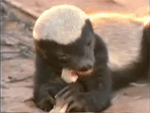 The honey badger (Mellivora capensis), or Ratel in Afrikaans, is the "most fearless animal in the world' according to the 2002 edition of the Guinness Book of Records. Watching National Geographic, I fell in love with these creatures. They do not fear anything! They plunder bee hives, kill snakes, etc. This video is an excerpt of the film "Snake killers: Honey badgers of the Kalahari" on National Geographic. A honey badger chases down a snake in a tree and eats it.
The honey badger (Mellivora capensis), or Ratel in Afrikaans, is the "most fearless animal in the world' according to the 2002 edition of the Guinness Book of Records. Watching National Geographic, I fell in love with these creatures. They do not fear anything! They plunder bee hives, kill snakes, etc. This video is an excerpt of the film "Snake killers: Honey badgers of the Kalahari" on National Geographic. A honey badger chases down a snake in a tree and eats it.
The Honey badger is listed as Least Concern (LR/lc), lowest risk. Does not qualify for a more at risk category. Widespread and abundant taxa are included in this category, on the IUCN Red List of Threatened Species
Namings for the honey badger
A young / baby of a honey badger is called a 'kit'. The females are called 'sow' and males 'boar'. A honey badger group is called a 'cete, colony, set or company'.Countries
Afghanistan, Algeria, Angola, Benin, Botswana, Burkina Faso, Burundi, Cameroon, Central African Republic, Chad, Congo, Democratic Republic of the, Congo, Republic of the, Cote d'Ivoire, Djibouti, Egypt, Equatorial Guinea, Eritrea, Ethiopia, Gabon, Gambia, The, Ghana, GuineaBissau, India, Iran, Iraq, Israel, Jordan, Kenya, Kuwait, Lebanon, Liberia, Malawi, Mali, Mauritania, Morocco, Mozambique, Namibia, Nepal, Niger, Nigeria, Oman, Pakistan, Rwanda, Saudi Arabia, Senegal, Sierra Leone, Somalia, South Africa, Sudan, Swaziland, Syria, Tanzania, Togo, Turkmenistan, Uganda, United Arab Emirates, Western Sahara, Yemen, Zambia and ZimbabweSome facts about the
Honey badger
Adult weight : 10 kg (22 lbs)
Maximum longevity : 31 years
Gestation : 180 days
Litter size : 2
Litters per year : 2
Weight at birth : 0.21 kg (0.462 lbs)

Custom Search